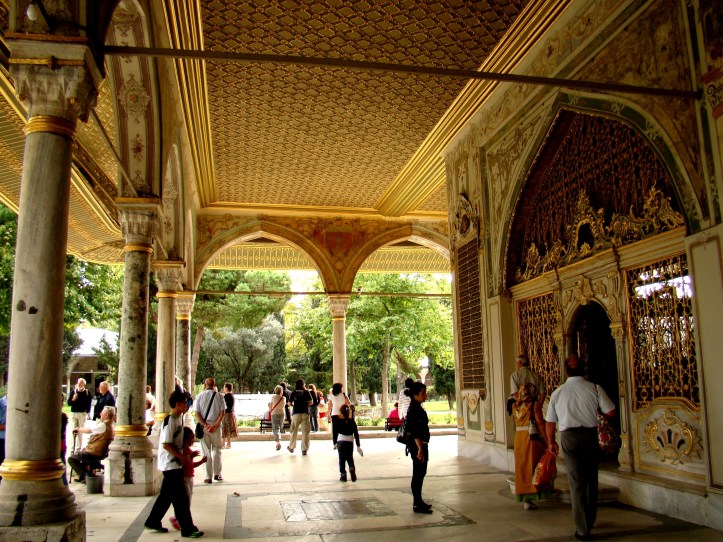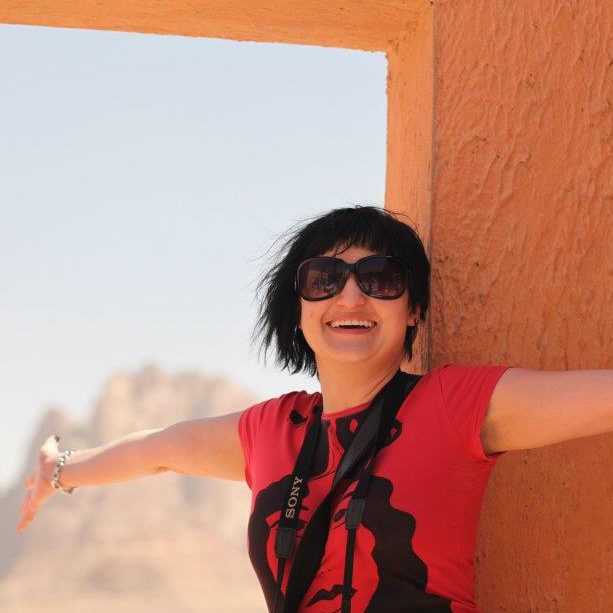When I hear “Palace” the picture of a Victorian building comes to mind, a grand building with gilded gold, surrounded by turrets and lots of grandeur. The Topkapi Palace of Istanbul did not disappoint.

You can easily spend a couple of hours exploring the Topkapi Palace, home to generations of sultans and their wives, who were closeted in the famous harem. The secretive harem – really just the family quarters – is a warren of lushly-tiled rooms wrapped round a gem of a Turkish bath. It was very crowded so I couldn’t get any good photos but there was the rest of the palace to explore so this wasn’t to big of a disappointment.
At its peak, the palace, built in 1459, was home to as many as 4,000 people, and contained mosques, a hospital, bakeries, and a mint.Following the end of the Ottoman Empire in 1923, Topkapı Palace was transformed into a museum of the imperial era.

The sultan would enter the palace through the marble Imperial Gate, so I did get to feel a bit like royalty as I walked through this decorated structure. Gilded Ottoman calligraphy adorns the structure at the top, with verses from the Qur’an and tughras of the sultans. This Gate is the main entrance into the four courtyards, each more exclusive than the previoius one, leading to the Fourth Courtyard, which was the sultan’s private courtyard.

I found the former Imperial Mint constructed in 1727, in the first courtyard as I walked through the beautiful gardens. To think these gardens all belonged to the sultan and his family and that they could close it off and have it all to themselves.
The sultan and his family could enjoy a maximum of privacy and discretion, as the Palace is filled with grilled windows and secret passageways. I would have loved to explore one of these pasageways but only the most important rooms and chambers are accessible to the public today.
Walking through this garden I entered the Second Courtyard of the palace where I was greeted by the first of many amazing Palace buildings. The Topkapi Palace is definitely filled with guilded gold and even the grilled windows shine with gold.
The Imperial Council building is the chamber in which the ministers of state, and other leading officials of the Ottoman state, held meetings. It is also called Kubbealtı, which means “under the dome”, in reference to the dome in the council main hall. These intricately decorated domes are in each of the buildings main rooms.

The small gilded ball that hangs from the ceiling represents the earth. It is placed in front of the sultan’s window and symbolises him dispensing justice to the world, as well as keeping the powers of his viziers in check. It reminded me of the fairytale where a princes plays outside with her golden ball which she then looses in a pond. In return of a kiss the golden ball is then retreived by a frog, who turns into a prince after receiving this kiss from the princess.

The porch consists of multiple marble and porphyry pillars, with an ornate green and white-coloured wooden ceiling, all decorated with gold. Personally I think they overdid the gold a bit, but I do like the grilled windows that give light as well as privacy.


The Tower of Justice is located between the Imperial Council and the Harem. The tower is several stories high and the tallest structure in the palace. The tower symbolizes the eternal vigilance of the sultan against injustice. Unfortunately the tower is closed to visitors, but there are countless rooms to explore in this huge Palace.












Reblogged this on mapsworldwide blog.
LikeLiked by 1 person
A big thank you for the re-blog!
LikeLike
Nice shots and weather seemed fine too; my visit was during a cold spell – misty and wet!
LikeLiked by 1 person
I could definitely not complain about the weather, it was sunny and although it was late autumn it wasnt too cold.
LikeLike
What a beautiful place.
LikeLiked by 1 person
Istanbul is filled with so many amazing buildings!
LikeLike
Another excellent post! I wonder how I will ever visit all these amazing places! : )
LikeLiked by 1 person
Thank you so much! I hope that during your travels you get to visit Istanbul, it is one of my all-time favourite cities!
LikeLike
Thank you for letting us travel with you on these amazing journey seeing places unreachable for most of us.
Peace!
LikeLike
You are welcome and a huge thank you for joining me on this journey!
LikeLiked by 1 person
Boy, you are on some journey
LikeLike
My Turkey adventure is definitely one of my favourites!
LikeLike
It’s one country I always wanted to visit
LikeLike
Istanbul is historical – You are taking me back to great memories.
Topkapi is the largest and oldest palace in the world to survive to our day. In 1924 it was turned into a museum at Atatiirk’s request. Situated on the acropolis, the site of the first settlement in Istanbul, it commands an impressive view of the Golden Horn, the Bosphorus and the Sea of Marmara. The palace is a complex surrounded by 5 km of walls and occupies an area of 700,000 sq. m at the tip of the historical peninsula.
LikeLike
I loved that Istanbul is filled with so much history and culture. And you are right, the views over the Bosphorus from the palace are amazing!
LikeLike